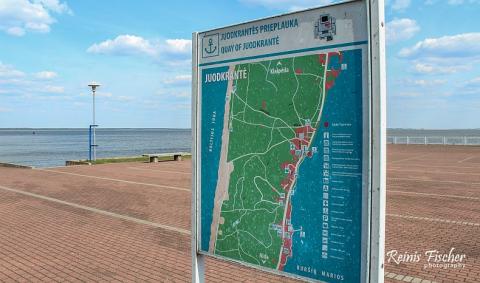Juodkrante is a seaside resort town located on Curonian Spit in Lithuania some 20km from Klaipeda. To get on to the Curonian Spit you will need to take a ferry at Smiltyine terminal at first.
I was really surprised of different architecture I seen here on Juodkrante and Curonian Spit. I you have ever been close to the Netherlands, you will find some similarities with Dutch architecture here, thus, most probably the architecture here is kept from times when Curonian Spit was part of Germany (prior to WW2). I did find some similarities here with Dutch town of Leiden, for example.

Juodkrante in Lithuania
Juodkrantė (literally: Black Shore) with permanent population of about 720 people is a quiet Lithuanian seaside resort village located on the Curonian Spit. A part of Neringa municipality, Juodkrantė is the second largest settlement on Lithuania's part of the spit.
Situated in Old Prussian territory it was for centuries a fishing village named Schwarzort, which underwent a tourist boom in the late 19th - early 20th century. After World War I this northern part of East Prussia was severed from Germany and the village became known as Juodkrantė.

Quay of Juodkrante
Juodkrantė was first mentioned (as Schwarzort) by the Teutonic Knights in 1429 in a letter describing storm damages. It was initially situated along the Baltic Sea shore, about 2.5 km from the present location. In the early 17th century, due to the Black Death, and moving sand dunes threatening to bury the village, it lost almost all of its inhabitants. In the 1680s, the village relocated to its present location along the Curonian Lagoon shore. After 1724, the sources do not mention the village along the Baltic Sea shore any more. The village did quite well in the new location: a tavern was opened in 1673, a school in 1743, and a wooden church in 1795. Until 1740 the village belonged to German: KreisMemel (Klaipėda County), then from 1740-1795 to Church District German: Kirchspiel Karwaiten (Karvaičiai). It grew in importance after Carwaiten/Karvaičiai/Karwaiten village was swallowed by traveling sand and the seat of the Church District relocated here. The wooden church burned down in 1878 but was soon replaced by a red brick Lutheran church in 1885.

Juodkrante
